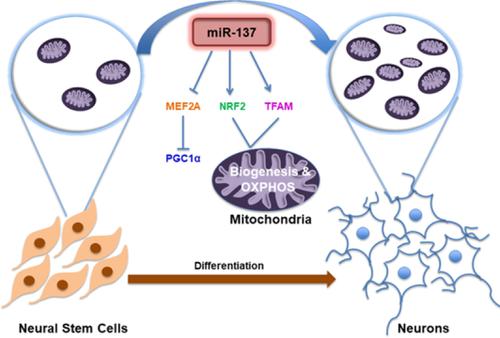当前位置:
X-MOL 学术
›
STEM CELLS
›
论文详情
Our official English website, www.x-mol.net, welcomes your feedback! (Note: you will need to create a separate account there.)
MiRNA-137-mediated modulation of mitochondrial dynamics regulates human neural stem cell fate
STEM CELLS ( IF 5.2 ) Pub Date : 2020-02-08 , DOI: 10.1002/stem.3155 Asha S Channakkar 1 , Tanya Singh 1, 2 , Bijay Pattnaik 3 , Karnika Gupta 1 , Pankaj Seth 1 , Yogita K Adlakha 1
STEM CELLS ( IF 5.2 ) Pub Date : 2020-02-08 , DOI: 10.1002/stem.3155 Asha S Channakkar 1 , Tanya Singh 1, 2 , Bijay Pattnaik 3 , Karnika Gupta 1 , Pankaj Seth 1 , Yogita K Adlakha 1
Affiliation

|
The role of miRNAs in determining human neural stem cell (NSC) fate remains elusive despite their high expression in the developing nervous system. In this study, we investigate the role of miR‐137, a brain‐enriched miRNA, in determining the fate of human induced pluripotent stem cells‐derived NSCs (hiNSCs). We show that ectopic expression of miR‐137 in hiNSCs reduces proliferation and accelerates neuronal differentiation and migration. TargetScan and MicroT‐CDS predict myocyte enhancer factor‐2A (MEF2A), a transcription factor that regulates peroxisome proliferator‐activated receptor‐gamma coactivator (PGC1α) transcription, as a target of miR‐137. Using a reporter assay, we validate MEF2A as a downstream target of miR‐137. Our results indicate that reduced levels of MEF2A reduce the transcription of PGC1α, which in turn impacts mitochondrial dynamics. Notably, miR‐137 accelerates mitochondrial biogenesis in a PGC1α independent manner by upregulating nuclear factor erythroid 2 (NFE2)‐related factor 2 (NRF2) and transcription factor A of mitochondria (TFAM). In addition, miR‐137 modulates mitochondrial dynamics by inducing mitochondrial fusion and fission events, resulting in increased mitochondrial content and activation of oxidative phosphorylation (OXPHOS) and oxygen consumption rate. Pluripotency transcription factors OCT4 and SOX2 are known to have binding sites in the promoter region of miR‐137 gene. Ectopic expression of miR‐137 elevates the expression levels of OCT4 and SOX2 in hiNSCs which establishes a feed‐forward self‐regulatory loop between miR‐137 and OCT4/SOX2. Our study provides novel molecular insights into NSC fate determination by miR‐137.
中文翻译:

miRNA-137 介导的线粒体动力学调节调节人类神经干细胞的命运
尽管 miRNA 在发育中的神经系统中高表达,但它们在确定人类神经干细胞 (NSC) 命运中的作用仍然难以捉摸。在这项研究中,我们研究了 miR-137(一种富含大脑的 miRNA)在确定人类诱导多能干细胞衍生的 NSC(hiNSC)命运中的作用。我们表明 miR-137 在 hiNSCs 中的异位表达减少增殖并加速神经元分化和迁移。TargetScan 和 MicroT-CDS 预测肌细胞增强因子-2A (MEF2A),一种调节过氧化物酶体增殖物激活受体-γ 共激活因子 (PGC1α) 转录的转录因子,作为 miR-137 的靶标。使用报告基因检测,我们验证 MEF2A 作为 miR-137 的下游靶标。我们的结果表明,降低 MEF2A 水平会减少 PGC1α 的转录,这反过来又会影响线粒体动力学。值得注意的是,miR-137通过上调核因子红细胞2(NFE2)相关因子2(NRF2)和线粒体转录因子A(TFAM),以PGC1α独立的方式加速线粒体生物发生。此外,miR-137通过诱导线粒体融合和裂变事件来调节线粒体动力学,导致线粒体含量增加和氧化磷酸化(OXPHOS)激活和耗氧率。已知多能性转录因子 OCT4 和 SOX2 在 miR-137 基因的启动子区域具有结合位点。miR-137 的异位表达提高了 hiNSCs 中 OCT4 和 SOX2 的表达水平,从而在 miR-137 和 OCT4/SOX2 之间建立了前馈自我调节回路。
更新日期:2020-02-08
中文翻译:

miRNA-137 介导的线粒体动力学调节调节人类神经干细胞的命运
尽管 miRNA 在发育中的神经系统中高表达,但它们在确定人类神经干细胞 (NSC) 命运中的作用仍然难以捉摸。在这项研究中,我们研究了 miR-137(一种富含大脑的 miRNA)在确定人类诱导多能干细胞衍生的 NSC(hiNSC)命运中的作用。我们表明 miR-137 在 hiNSCs 中的异位表达减少增殖并加速神经元分化和迁移。TargetScan 和 MicroT-CDS 预测肌细胞增强因子-2A (MEF2A),一种调节过氧化物酶体增殖物激活受体-γ 共激活因子 (PGC1α) 转录的转录因子,作为 miR-137 的靶标。使用报告基因检测,我们验证 MEF2A 作为 miR-137 的下游靶标。我们的结果表明,降低 MEF2A 水平会减少 PGC1α 的转录,这反过来又会影响线粒体动力学。值得注意的是,miR-137通过上调核因子红细胞2(NFE2)相关因子2(NRF2)和线粒体转录因子A(TFAM),以PGC1α独立的方式加速线粒体生物发生。此外,miR-137通过诱导线粒体融合和裂变事件来调节线粒体动力学,导致线粒体含量增加和氧化磷酸化(OXPHOS)激活和耗氧率。已知多能性转录因子 OCT4 和 SOX2 在 miR-137 基因的启动子区域具有结合位点。miR-137 的异位表达提高了 hiNSCs 中 OCT4 和 SOX2 的表达水平,从而在 miR-137 和 OCT4/SOX2 之间建立了前馈自我调节回路。


























 京公网安备 11010802027423号
京公网安备 11010802027423号